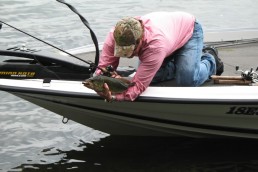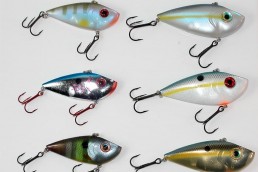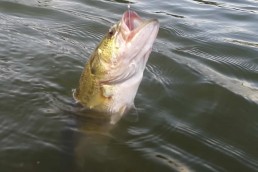Rattle ‘em Up: Lipless Cranks are Tops for Bass
SHARE THIS POST
“This is too easy!” I yelled back to Joel, as I slipped another chunky smallmouth into the drink.
Both of us were experiencing a dream come true. During the early 1990s, Joel Isenberg and I ventured out twice a week. That’s when I discovered the power of vibration crankbaits. Often called rattle baits or lipless crankbaits, these odd-looking lures are amazing. Similar to a traditional crankbait, its profile is that of a baitfish but without a diving lip. Instead, the top of the head is flatted and creates a tight wiggling action when the lure is retrieved.
Another unique feature is that they aren’t buoyant. This is helpful for achieving a range of running depths. Simply allow it to sink to a desired depth then start cranking. Surprisingly, these diamond-shaped lures are versatile and range from 1/4 to 3/4 ounce with 1/2 being the most popular.
On the windswept morning on Lake Simcoe, we battled harsh waves. Reaching our favorite rocky point, we instantly started zinging rattle baits. Wicked wind whipped the water so manically that finesse fishing was out of the question. We casted parallel to a long underwater point, and hit the mother lode. Smallmouth after smallmouth smashed our cranks. We never hit any of the lake’s famed giants, but got 3- and 4-pounders.
Cranking is vigorous; lazy anglers need not apply. You’ll need to work for your fish, but the rewards are worth it. Technically, the presentation is fairly easy: tons of casting and reeling. Tuning the equipment to the fishing conditions will ease most of the grunt work. The rod action, line size, retrieve speed and lure weight all need to be considered when fine-tuning a day on the water. But don’t scoff—if the tackle isn’t working together, you’ll never understand how lethal these baits can be.
Flinging baits far and constant cranking is the domain of baitcasting. A good starting point is a longer, medium-action rod. Rod lengths can vary from 6 1/2 to 8 feet. A great cranking rod needs a comfortable grip and flexible action. E-Glass or fiberglass-blended blanks are tailor-made for this. Softer actions launch baits well into the stratosphere while helping to reduce fatigue. The flexibility also ensures bass stay pinned during the battle. Don’t overpower fish during the fight and take full advantage of the limp, parabolic action to wear down these scrappy fish. Stiffer rods strain line and tear hooks, and undesirable outcomes.
Two close friends have spent considerable time honing their cranking skills.
“Last year, I really concentrated on dialing in my setup,” Marcello Carbone said.
He switched to a 7-foot Fenwick Aetos cranking rod and a Shimano Core 100 MG 6.2:1 baitcasting reel.
He feels that this ratio is quick enough, but not overkill.
“You don’t need the super-fast reels; I’ve never had to burn ultra-fast to make them bite. A 6.2:1 reel is still fast, but lets you go slow enough that you’re not over cranking.”
Marcello also has made the transition to fluorocarbon line and spools up with either 14- or 17-pound Maxima line. Marcello fishes lakes that are gin-clear. Fluorocarbon, being almost invisible, allows him to get away with a heavier pound test.
“I continue to stick with mono, but I might switch solely to fluorocarbon for clearer smallmouth lakes.”
Joel has always been a big fan of rattle baits. His setup is similar to Marcello’s.
“I love the 7-foot, medium-action Shimano Cumara Rod,” he says.
Joel had to retire due to chronic shoulder problems. A longer rod offers greater support for his ailing shoulder. Again, his Abu Revo cranking reel has a fast ratio of 6.4:1, but he matches the outfit with 10-pound-test Berkley Big Game monofilament. He finds the mono provides just enough stretch and casts well.
Picking the correct line size plays a huge role. Scaling up to 20-pound-test will help float the lure over shallow grass easier than 12-pound line. But remember, crankbaits are most effective when they tick cover, and not get bogged down in it. Monofilament still is supreme, and braids have been touted for a lack of stretch. But with vibration baits, a bit of stretch is a good thing. Spooling heavy line is ideal if your bass lakes are brimming with weeds, but if you need to fish deeper, scaling down to 10-pound-test is wise.
Are you enjoying this post?
You can be among the first to get the latest info on where to go, what to use and how to use it!
Joel is a big fan of sticking to 10-pound-test line. Most of his cranking is over deeper weed flats and he finds that lighter line helps the bait stay down on a quick retrieve.
Snap it
To maximize the fish-catching action of a lipless crankbait, use a snap. A snap allows lures to run freely and eliminates constant retying. If one is not a fan, then at least use a loop knot. Remove the split ring to avoid the line rubbing on its sharp edges and tie directly to the lure. The Rapala or King Sling knots are both easy to tie and are strong.
Changing hooks is another worthwhile task here. Marcello switches to either Owner or Mustad 2X Black trebles.
“I’ve been a fan of Red Mustad trebles as of late,” he says. “I replace the belly hook, as it hasn’t really made a difference with my catch rate, but it hasn’t hurt it either.”
Ripping the grass
Grass beds are a haven for bass, sometimes hundreds, and vibration baits are just the lure for finding them. The flash and vibration draws them out, but treble hooks and weeds aren’t friends. This is where balanced tackle really comes in to play. Running the baits just over submerged grass is a constant adjustment of rod position and reel speed. When the bait collides with a stalk of grass, deliver a sharp sideway yank to rip it free. Ripping the bait triggers the most aggressive hits.
Focus your efforts along channels, clearings or edges in the weeds, as all spots are worth multiple casts. If you’re struggling to free weeds, upgrade to a medium-heavy-action rod. Re-spooling with fused or braided line should be a last resort, but it can work. Just be sure to be gentle when fighting the feistier fish.
Don’t leave a biting school. Undisciplined anglers make the common mistake of catching a few aggressive fish and then moving on. Hitting a honey hole is what dreams are made of. Work the area over and over. Vary casting angles, retrieve speeds and bait colors. Often, you’ll need to sort through a few smaller ones before nailing a beast.
Bait selection is personal. All vibration cranks have the same general design and profile, and almost every hard bait manufacturer has one in their line up. Joel, Marcello and I all keep color selection fairly basic: chrome, gold and natural finishes are all tops. Flash is a tremendous attractant too; baits that glitter and rattle loudly are winners.
Rocking the rocks
Vibration baits score well with smallmouths, but clear waters make shallow smallmouths spooky. Keeping the bait buzzing at a brisk pace is a great strategy to avoid it being scrutinized.
“Sandy bottoms with rock rubble and some spare weeds is perfect smallmouth cover,” Marcello says.
Last year, Marcello discovered in late summer and into fall that smallmouths flock to these areas en masse.
“Swimming the lure works well, but most often, it has to deflect off cover” Carbone said.
One trick he has uncovered is that noisy baits are not always the best.
“Silent or near-silent baits—vibration baits without rattles are a rare and cherished find—are really effective when the water turns calm. In clear, slick water, smallmouths often become most leery. Switching to quieter rattle baits has been the ticket.”
Although Marcello really doesn’t favor one bait, he’s dying to try Koppers Live Target Crawfish Trap, Rapala’s Clackin’ Rap and the XCalibur One Knocker, as these baits are said to be silent killers.
Vibration baits are versatile lures, and are effective on bass. Follow these simple ground rules and you’ll have one tied on every day of the season, just like we do.
MWO
SHARE THIS POST
Did you enjoy this post?
You can be among the first to get the latest info on where to go, what to use and how to use it!
Luigi De Rose
Luigi De Rose, has been crafting articles for the last 25 years. Loving anything fishing, especially bass fishing, Luigi has been lucky enough to fish on three continents. Currently, he is the bass editor at Ontario OUT of DOORS magazine and owner of IBASSIN.com, a blog decided to all things bass. His articles have graced the pages of Bassmaster, In-Fisherman and MidWest Outdoors to name a few. When not fishing, you can find him with his two girls and wife in the outdoors.



